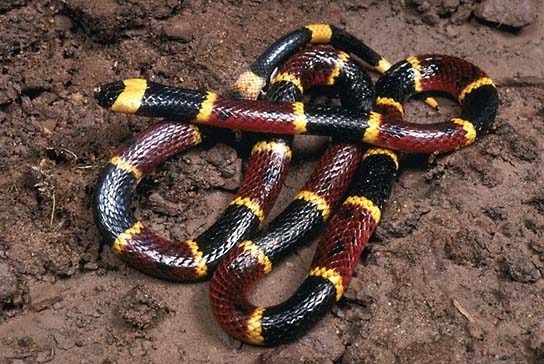Venomous Snakes

Snakes may be found in every natural habitat in Florida, and make their homes in trees, shrubs, soil, marshes, swamps, ponds and lakes.
Of the 45 species and 44 subspecies of snakes found in Florida, 6 are venomous, or poisonous.
If you find a snake and you do not know whether it is venomous or not, the safest thing to do is leave it alone. While most Florida snakes are not aggressive and will flee when humans approach, when they are cornered or bothered, they will attack.
Snake bites can be deadly. If you are bitten by a snake, take immediate action! Call 9-1-1 immediately so emergency medical services can respond as soon as possible or seek attention at the nearest hospital or medical facility. The only acceptable treatment for a venomous snakebite involves the use of antivenom, and it must be administered as early as possible, which will take place only in a hospital setting.
Once a person has been bitten by a snake, the following symptoms may appear:
• Marks in the skin and swelling of the site of the snake bite.
• Discharge blood from the wound.
• Severe pain around the bite site.
• Convulsion of varying severity.
• Blurred vision, weakness, dizziness and fainting.
Treating a Snake Bite:
STAY CALM
• Safety First: Get away from the snake. That’s probably why it bit in the first place.
• Limit Patient Movement (Walking or other physical actions)
• Call 9-1-1 immediately! Waiting to long to call for help may lead to permanent tissue damage.
• DO NOT elevate: Keep the bite below the level of the heart.
• Remove constricting clothing and jewelry from the extremity.
• Wash the area with warm water and soap.
• If the snake is a coral or a cobra, wrap the extremity with an elastic pressure bandage. Start with the point closest to the heart and wrap towards the fingers or toes. Continue to keep bite lower than the heart.
• Be concerned about the potential for shock. Keep warm and check for proper breathing.
• Always follow up with your doctor for any other treatment necessary.
Busting the Myths:
• No cutting or sucking bite: Cutting into the wound will just create infections. Sucking the venom from the wound does not guarantee venom removal.
• DO NOT use ice: Ice does not deactivate the venom and can cause frostbite.
• DO NOT use alcohol: Alcohol may deaden the pain, but also makes the local blood vessels bigger, which can increase venom absorption.
• DO NOT use tourniquets or constricting bands: They are not effective, can cause increased tissue damage and could cost the victim a limb.
Finally, some safety tips that may eliminate the potential of becoming a victim of snake bites:
• Wear long pants and boots taller than the ankle when outside in the woods.
• Avoid tall brush and deep, dark crevices.
• Wear gloves when gardening or trimming bushes and trees.
• Make plenty of noise and vibration while walking. This may scare the snake away.
• DO NOT approach snakes, avoid them.
• DO NOT expect rattlesnakes to make any noise.
• DO NOT attempt to pick up, catch or kill snakes for identification. If you have a cell phone with a camera, take a picture or try to give a good description of what the snake looked like to emergency or hospital personnel.
• Sit still if a snake crawls on you or is close by.
• Use caution when boating under low hanging limbs and branches.
• When you have the opportunity to learn about snakes and recognize venomous snakes, do so. It’s for your own protection and knowledge.
Knowing how to avoid snakes and what to do if you do get bitten by a snake, may help save your life! And one other tip...In case you didn’t know, for a short time after a snake is killed, its reflexes may continue to work, so don’t poke or prod a freshly killed snake. It can cause a contraction and a bite.
This information is provided to you by The Osceola County Department of Fire Rescue and Emergency Medical Services. Stay Safe!

